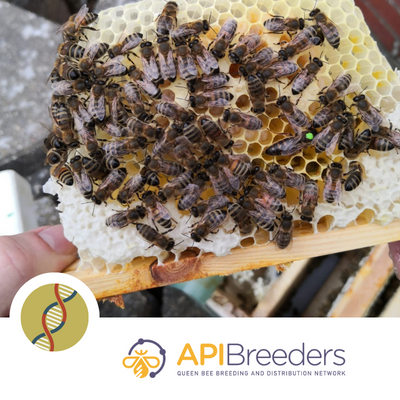
APIBreeders through its traceability platform provides to the breeder the information on the performance of the queens at the destination, as well as the genetic variability that exists between the mothers (F0) of the breeding apiary and the offspring of the queens that markets.
In order to carry out a plan for the genetic improvement of the hives, biological and mathematical-statistical principles are applied that serve to take advantage of the existing genetic variation within a certain hive. This results in obtaining a bee highly adapted to the region, maximizing the benefits available resources of the apiary: applying the selective breeding of the individuals.
Genetics is the science that studies the inheritance and variability of characters in living organisms. It is the analysis of how the characteristics of living organisms are passed from parents to offspring and how these vary in individuals of the same species. Genetic breeding and selective breeding are complementary.
Therefore, the selection of the bee colonies -the hives-, which stand out in search of more important characteristics for the beekeeper such as honey production, bees, health, gentleness, etc. which can be inherited for transmission to the offspring is the axis of the hive genetic improvement plan.
To this we must add the concepts of Phenotype and Genotype, terms used in genetics and reproduction. Phenotype is the bee colony's expression of a measurable characteristic that is the result of genetics and the environment. Example in kilograms of honey, where one hive produces 50 kilograms and another 100 kilograms (phenotypic expression).
The genotype is the proportional part of the total expression (phonotypic) of a characteristic that is due solely to genetics, following for the same example the hive that produced 100 kilos of honey, the genes of the bees are responsible for 40 kilos of honey. , while due to environmental factors (management, climate, nectar availability, etc.) they contributed 60 kilos of honey. So, the genotype is responsible for 40 kilos and environmental factors contributed 60 kilos; In other words, 40% of the phenotype of that colony is due to the Genotype.
For beekepers who intend to achieve genetic gain quickly, it is necessary to predict as accurately as possible the genetic value of the evaluated colonies, that is, to detect the phenotypically superior colonies. For that, the registered data must be analyzed and the breeder must classify the superior colonies and select them. Then, previously, a simple, practical and precise registration form must be established.
Through its traceability platform, the network provides the hatcheries with information on the performance of the queens at the destination, as well as the genetic variability that exists between the mothers (F0) of the breeding apiary and the offspring of the queens that markets.
This allows the kennel to put together its genetic improvement plan, give value and improve performance to its queens.
Define this text in TornadoStore Control.
We use cookies to customise and improve the content delivered to you, making sure you'll get the best online shopping experience. By clicking "Accept All Cookies", we can continue to show personalised offers and inspiration, based on the things you like. If you want to learn more about cookies and why we use them, visit our Cookie Policy page anytime.